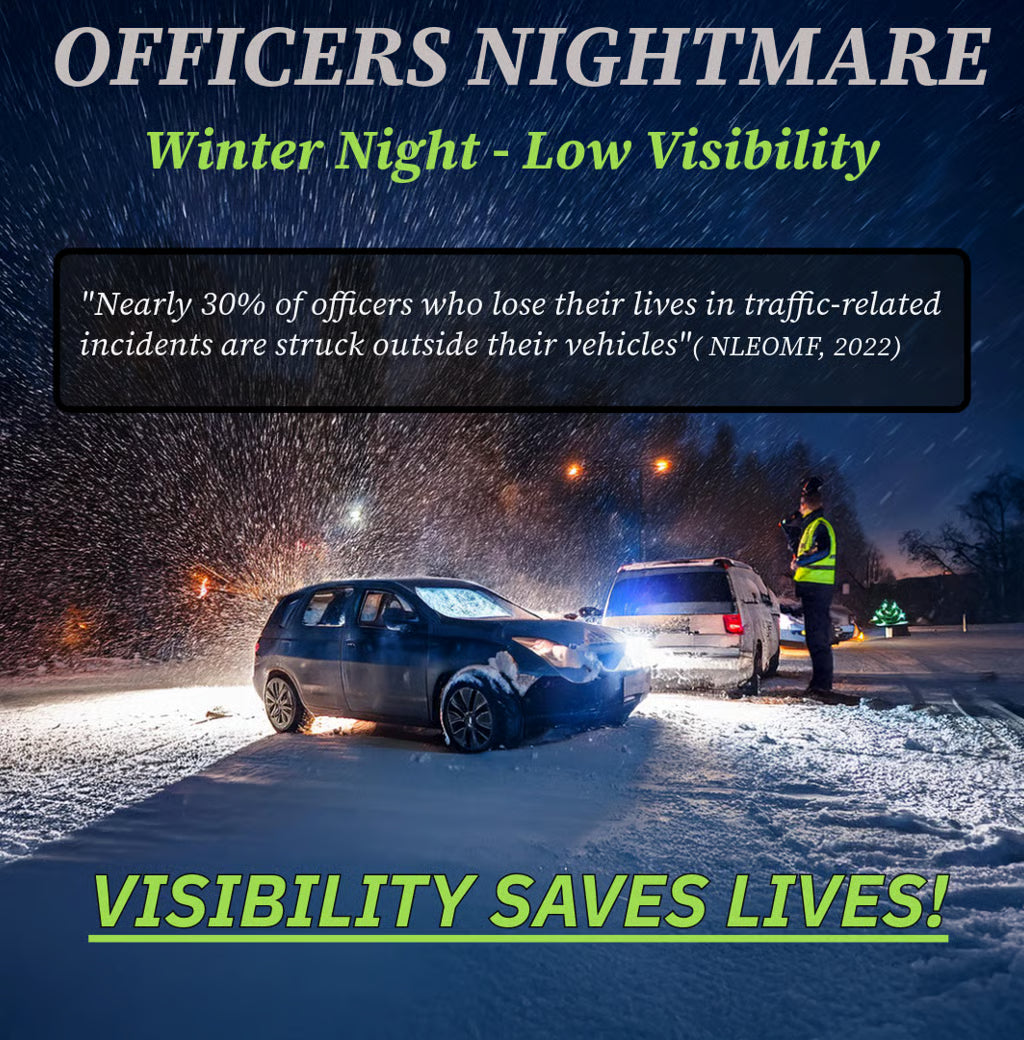
Staying Safe on the Winter Roadside: 10 Essential Tips for Law Enforcement Officers
Share
Roadside incidents are among the most dangerous situations law enforcement officers face. Whether responding to a traffic accident, assisting a stranded motorist, or conducting a roadside investigation, officers place themselves in harm’s way every time they step out of their vehicle. The data is sobering: nearly 30% of officers who lose their lives in traffic-related fatalities are struck outside their vehicles. The dangers are real, but officers can significantly reduce the risks with proper preparation and situational awareness.
1. Position Your Vehicle Strategically
Your patrol car is your first line of defense. Park it at an angle to shield the scene and create a physical barrier between traffic and the incident. Proper vehicle positioning protects you and can help channel motorists in a safer direction, reducing confusion and improving traffic flow.
Additional Tip: How you position your vehicle can significantly influence the behavior of oncoming drivers. Use it to guide traffic safely around the incident. Try to avoid motorist confusion.
2. Use Emergency Lighting Effectively
Maximize your visibility by using emergency lights effectively. In addition to your patrol car’s lights, consider using portable warning lights like DARKWING TECH’s OWL lights. These versatile lights can attach to traffic cones, disabled vehicles, or hazardous areas to increase visibility and provide clear warnings to drivers.
Additional Tip: Use the directional mode on your emergency lightbar to safely guide traffic around the scene.
3. Call for Backup When Needed
When you first analyze the scene, there’s no harm in requesting additional units for traffic control. An extra set of hands can mean the difference between a chaotic and a controlled situation. You can always cancel backup requests if the situation improves or warrants fewer resources.
Additional Tip: Know what traffic control equipment your backing officers have. Don't be afraid to give them specific instructions before their arrival. This provides backing officers with an idea of what direction to take to avoid unnecessary routes to the scene.
4. Wear High-Visibility Gear
Always wear reflective or high-visibility clothing while working near traffic. High-visibility gear is not just limited to safety vests—it can include items like hats, gloves, or jackets, which increase the surface area of visibility. This ensures drivers can see you from a greater distance, giving them more time to react.
Additional Tip: Did you know there are different safety ratings for high-visibility vests? Departments should research which levels are required for the roadways and areas their officers work in to ensure proper protection.
5. Stay Alert to Surroundings
Keep an eye on your surroundings at all times. Be mindful of drivers who may be distracted, confused, or disoriented as they approach the scene. Maintaining situational awareness can prevent accidents before they happen.
Additional Tip Supervisors: As a police supervisor, I made it a point to help my officers on accident scenes. My primary focus was the scene's safety, freeing up the officers for the investigation. Make sure officers are wearing some HIVIS accessories.
Additional Tip Officers: Turn up your radio and pay attention to dispatch. Officers should pause and re-evaluate the scene's safety every time dispatch conducts a CODE 4 (safety check). Don’t just respond quickly without verifying your safety is TRULY safe.
6. Limit Time in the Roadway
The less time you spend in the roadway, the lower your risk. Conduct tasks on the shoulder or behind protective barriers whenever possible. Only step onto the road when absolutely necessary, and always be aware of oncoming traffic. Depending on the situation or department policy, move to a parking lot or safe area away from the roadway.
Additional Tip: Avoid spending unnecessary time in vulnerable positions, especially during high-traffic periods or in poor visibility conditions.
7. Communicate Clearly
Clear communication with other officers, motorists, and emergency personnel is key to maintaining safety on the scene. Use hand signals, verbal instructions, or portable communication devices to ensure everyone understands their role and the traffic flow plan.
Additional Tip: Effective communication helps reduce confusion, which can prevent further accidents. Clear instructions help both responders and motorists navigate safely.
8. Use Traffic Cones and Barriers
Traffic cones and portable barriers are invaluable tools for channeling traffic and marking hazards. Arrange them strategically to create clear lanes and guide motorists away from the incident. Some officers are artists when setting up cones, but avoid overcomplicating your objective.
Additional Tip: Traffic cones with reflective collars and signage are especially useful. Compact, affordable signage that attaches to cones can help guide drivers effectively and is easy to store in patrol vehicles.
9. Avoid Standing Between Vehicles
Avoid placing yourself in areas where you could be pinned, such as between your patrol car and another vehicle. This is one of the most dangerous positions during roadside operations.
Additional Tip: Always maintain an escape route and avoid standing in “blind zones” where drivers may not see you.
ADDITIONAL TIP SAFETY ALERT: Don't forget about our tow truck drivers. They are unsung heroes when it comes to winter safety. They often have to walk between vehicles and objects to do their jobs. Please provide traffic control and watch out for their safety.
10. Train Regularly on Traffic Safety
Traffic safety training is vital to protecting officers on the road. Departments should prioritize ongoing education, including policy updates, equipment use, and best practices for managing roadside incidents.
Additional Tip: Sometimes, departments don’t prioritize traffic safety training due to other pressing needs. However, this training is critical for officer safety. Work with local Highway Patrol or State Troopers to gain insight into high-traffic scenarios and best practices.
Disclaimer:
The tips provided above are based on the personal opinions and experiences of a retired police supervisor. They are not official recommendations or policies and should not replace formal training or department guidelines.
CITATION: National Law Enforcement Officers Memorial Fund: https://nleomf.org